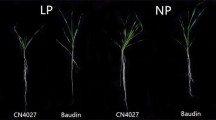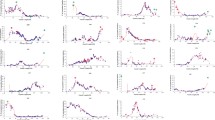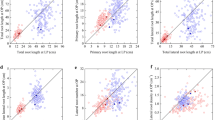Abstract
Phosphorus (P) deficiency in soils is a major limiting factor for plant growth worldwide. Plants have developed adaptive strategies in response to P deficiency. The objective of this study was to map quantitative trait loci (QTL) for P efficiency using a recombinant inbred (RI) population consisting of 124 lines derived from a cross between Brassica napus P-inefficient cv. B104-2 and P-efficient cv. Eyou Changjia. Six traits (shoot dry weight, root dry weight, root/shoot ratio, P concentration, shoot P uptake and shoot P use efficiency) at vegetative stage were examined under high P (HP, 1 mM) and low P (LP, 5 μM) conditions during three separate experimental trial periods. Their relative values (i.e., the ratio of a trait value under the LP condition to that under the HP condition) of these six traits were also determined. Eyou Changjia produced more biomass and acquired more P under the LP condition and, thus, had a higher relative dry weight and relative P uptake than B104-2, indicating Eyou Changjia was high P efficiency. A total of 71 QTL were detected on 13 linkage groups, including 28 QTL under the LP condition, 22 QTL under the HP condition and 21 QTL for relative traits. Nineteen and nine QTL were specific for the LP and HP conditions, respectively, suggesting that different mechanisms existed under the two P condition. Twelve of the twenty-one QTL for relative traits co-localized with QTL identified under the two P conditions. In addition, 18 orthologous genes involved in the P metabolic pathway of Arabidopsis were in silico mapped to the QTL confidence intervals identified in B. napus by comparative genomic analysis. These QTL and their corresponding candidate genes should be further investigated to better understand P efficiency in B. napus.




Similar content being viewed by others
References
Arcade A, Labourdette A, Falque M, Mangin B, Chardon F, Charcosset A, Joets J (2004) BioMercator: integrating genetic maps and QTL towards discovery of candidate genes. Bioinformatics 20:2324–2326
Batten GD (1992) A review of phosphorus efficiency in wheat. Plant Soil 146:163–168
Beebe SE, Rojas-Pierce M, Yan XL, Blair MW, Pedraza F, Munoz FM, Tohme J, Lynch JP (2006) Quantitative trait loci for root architecture traits correlated with phosphorus acquisition in common bean. Crop Sci 46:413–423
Carpenter SR (2008) Phosphorus control is critical to mitigating eutrophication. Proc Natl Acad Sci USA 105:11039–11040
Churchill GA, Doerge RW (1994) Empirical threshold values for quantitative trait mapping. Genetics 138:963–971
Duan HY, Shi L, Ye XS, Wang YH, Xu FS (2009) Identification of phosphorous efficient germplasm in oilseed rape. J Plant Nutri 32:1148–1163
Hammond JP, White PJ (2008) Sucrose transport in the phloem: integrating root responses to phosphorus starvation. J Exp Bot 59:93–109
Hammond JP, Broadley MR, White PJ, King GJ, Bowen HC, Hayden R, Meacham MC, Mead A, Overs T, Spracklen WP, Greenwood DJ (2009) Shoot yield drives phosphorus use efficiency in Brassica oleracea and correlates with root architecture traits. J Exp Bot 60:1953–1968
Hermans C, Hammond JP, White PJ, Verbruggen N (2006) How do plants respond to nutrient shortage by biomass allocation? Trends Plant Sci 11:610–617
Heuer S, Lu XC, Chin JH, Tanaka JP, Kanamori H, Matsumoto T, De Leon T, Ulat VJ, Ismail AM, Yano M, Wissuwa M (2009) Comparative sequence analyses of the major quantitative trait locus phosphorus uptake 1 (Pup1) reveal a complex genetic structure. Plant Biotechnol J 7:456–471
Hoagland DR, Arnon DI (1950) The water-culture method for growing plants without soil. California Department of Agriculture experimental station circular 347
Holford ICR (1997) Soil phosphorus: its measurement, and its uptake by plants. Aust J Soil Res 35:227–240
Hossain MA, Khan MSA, Nasreen S, Islam MN (2006) Effect of seed size and phosphorus fertilizer on root length density, P uptake, day matter production and yield of groundnut. J Agric Res 44:127–137
Ismail A, Heuer S, Thomson M, Wissuwa M (2007) Genetic and genomic approaches to develop rice germplasm for problem soils. Plant Mol Bio 65:547–570
Jain A, Vasconcelos MJ, Raghothama KG, Sahi SV (2007) Molecular mechanisms of plant adaptation to phosphate deficiency. In: Janick J (ed) Plant breeding reviews, vol 29. Wiley, NJ, pp 359–419
Li YD, Wang YJ, Tong YP, Gao JG, Zhang JS (2005) QTL mapping of phosphorus deficiency tolerance in soybean (Glycine max L. Merr.). Euphytica 142:137–142
Li JZ, Xie Y, Dai AY, Liu LF, Li ZC (2009) Root and shoot traits responses to phosphorus deficiency and QTL analysis at seedling stage using introgression lines of rice. J Genet Genomics 36:173–183
Liu J, Yang JP, Li RY, Shi L, Zhang CY, Long Y, Xu FS, Meng JL (2009) Analysis of genetic factors that control shoot mineral concentrations in rapeseed (Brassica napus) in different boron environments. Plant Soil 320:255–266
Long Y, Shi JQ, Qiu D, Li RY, Zhang CY, Wang J, Hou JN, Zhao JW, Shi L, Park BS, Choi SR, Lim YP, Meng JL (2007) Flowering time quantitative trait Loci analysis of oilseed brassica in multiple environments and genomewide alignment with Arabidopsis. Genetics 177:2433–2444
Lynch JP (2007) Roots of the second green revolution. Aust J Bot 55:493–512
Marschnera P, Solaimana Z, Rengel Z (2007) Brassica genotypes differ in growth, phosphorus uptake and rhizosphere properties under P-limiting conditions. Soil Biol Biochem 39:87–98
Ni JJ, Wu P, Senadhira D, Huang N (1998) Mapping QTLs for phosphorus deficiency tolerance in rice (Oryza sativa L.). Theor Appl Genet 97:1361–1369
Piquemal J, Cinquin E, Couton F, Rondeau C, Seignoret E, Doucet I, Perret D, Villeger MJ, Vincourt P, Blanchard P (2005) Construction of an oilseed rape ( Brassica napus L.) genetic map with SSR markers. Theor Appl Genet 111:1514–1523
Raboy V, Young KA, Dorsch JA, Cook A (2001) Genetics and breeding of seed phosphorus and phytic acid. J Plant Physiol 158:489–497
Reymond M, Svistoonoff S, Loudet O, Nyssaume L, Desnos T (2006) Identification of QTL controlling root growth response to phosphate starvation in Arabidopsis thaliana. Plant Cell Environ 29:115–125
Schachtman DP, Shin R (2007) Nutrient sensing and signaling: NPKS. Annu Rev Plant Biol 58:47–69
Schranz ME, Lysak MA, Mitchell-Olds T (2006) The ABC’s of comparative genomics in the Brassicaceae: building blocks of crucifer genomes. Trends Plant Sci 11:535–542
Shimizu A, Yanagihara S, Kawasaki S, Ikehashi H (2004) Phosphorus deficiency-induced root elongation and its QTL in rice (Oryza sativa L.). Theor Appl Genet 109:1361–1368
Solaiman Z, Marschner P, Wang D, Rengel Z (2007) Growth, P uptake and rhizosphere properties of wheat and canola genotypes in an alkaline soil with low P availability. Biol Fert Soils 44:143–153
Su JY, Xiao YM, Li M, Liu QY, Li B, Tong YP, Jia JZ, Li ZS (2006) Mapping QTLs for phosphorus-deficiency tolerance at wheat seedling stage. Plant Soil 281:25–36
Su JY, Zheng Q, Li HW, Li B, Jing RL, Tong YP, Li ZS (2009) Detection of QTLs for phosphorus use efficiency in relation to agronomic performance of wheat grown under phosphorus sufficient and limited conditions. Plant Sci 176:824–836
Svistoonoff S, Creff A, Reymond M, Sigoillot-Claude C, Ricaud L, Blanchet A, Nussaume L, Desnos T (2007) Root tip contact with low-phosphate media reprograms plant root architecture. Nat Genet 39:792–796
Vance CP, Uhde-Stone C, Allan DL (2003) Phosphorus acquisition and use: critical adaptations by plants for securing a nonrenewable resource. New Phytol 157:423–447
Wang SC, Bastern J, Zeng ZB (2006) Windows QTL Cartographer 2.5. Department of Statistics, North Carolina State University, Raleigh
Wissuwa M (2003) How do plants achieve tolerance to phosphorus deficiency? Small causes with big effects. Plant Physiol 133:1947–1958
Wissuwa M, Yano M, Ae N (1998) Mapping of QTLs for phosphorus-deficiency tolerance in rice (Oryza sativa L.). Theor Appl Genet 97:777–783
Wissuwa M, Wegner J, Ae N, Yano M (2002) Substitution mapping of Pup1: a major QTL increasing phosphorus uptake of rice from a phosphorus-deficient soil. Theor Appl Genet 105:890–897
Yan XL, Liao H, Beebe SE, Blair MW, Lynch JP (2004) QTL mapping of root hair and acid exudation traits and their relationship to phosphorus uptake in common bean. Plant Soil 265:17–29
Yan XL, Wu P, Ling HQ, Xu GH, Xu FS, Zhang QF (2006) Plant nutriomics in China: an overview. Ann Bot (Lond) 98:473–482
Yang M, Ding GD, Shi L, Feng J, Xu FS, Meng JL (2010) Quantitative trait loci for root morphology in response to low phosphorus stress in Brassica napus. Theor Appl Genet 121:181–193
Zeng ZB (1994) Precision mapping of quantitative trait loci. Genetics 136:1457–1468
Zhang D, Cheng H, Geng LY, Kan GZ, Cui SY, Meng QC, Gai JY, Yu DY (2009a) Detection of quantitative trait loci for phosphorus deficiency tolerance at soybean seedling stage. Euphytica 167:313–322
Zhang HW, Huang Y, Ye XS, Shi L, Xu FS (2009b) Genotypic differences in phosphorus acquisition and the rhizosphere properties of Brassica napus in response to low phosphorus stress. Plant Soil 320:91–102
Zhu JM, Kaeppler SM, Lynch JP (2005a) Mapping of QTL controlling root hair length in maize (Zea mays L.) under phosphorus deficiency. Plant Soil 270:299–310
Zhu JM, Kaeppler SM, Lynch JP (2005b) Mapping of QTLs for lateral root branching and length in maize (Zea mays L.) under differential phosphorus supply. Theor Appl Genet 111:688–695
Zhu JM, Mickelson SM, Kaeppler SM, Lynch JP (2006) Detection of quantitative trait loci for seminal root traits in maize (Zea mays L.) seedlings grown under differential phosphorus levels. Theor Appl Genet 113:1–10
Acknowledgement
This work was supported by grants from the National Basic Research and Development Program (2005CB120905), and the National 863 High Technology Program (2006AA10A112), China.
Author information
Authors and Affiliations
Corresponding author
Additional information
Responsible Editor: Johan Six.
Electronic supplementary material
Below is the link to the electronic supplementary material.
Table S1
All QTL detected in B. napus for seed weight, seed P concentration and related traits under the LP and HP conditions in the three nutrient solution experiments. (DOC 161 kb)
Rights and permissions
About this article
Cite this article
Yang, M., Ding, G., Shi, L. et al. Detection of QTL for phosphorus efficiency at vegetative stage in Brassica napus . Plant Soil 339, 97–111 (2011). https://doi.org/10.1007/s11104-010-0516-x
Received:
Accepted:
Published:
Issue Date:
DOI: https://doi.org/10.1007/s11104-010-0516-x




